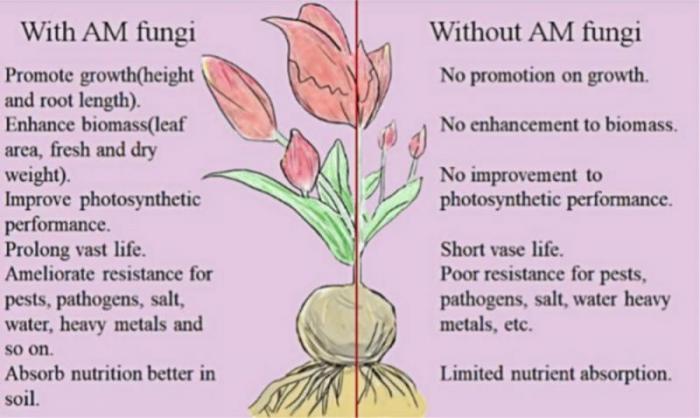What is AMF?
AMF refers to the group of ancient fungi that have the capacity to symbiote with around 80% of vascular plants. They form unique structures called vesicles or dichotomously branching structures known as arbuscules which are vital sites of nutrient exchange. These Arbuscule Mycorrhizal Fungi (or AMF for short), belong exclusively to the Glomermycota phylum of the fungi kingdom and have been identified as being extremely crucial in the initial colonization of the land by vascular plants and their subsequent evolution, around ~ 460 million years ago.
To form these arbuscules, the fungi penetrate the cortical cells of vascular plant roots that can be inside the root structure (endo) or outside of it (ecto). Arbuscules are sites used for nutrient exchange between the plants’ roots and the hyphae of the fungi in which a multitude of compounds are passed between the two in a sort of mutualistic negotiation that appears to benefit both parties greatly. A few of the exchanged compounds at these sites are sugars, fats, carbon, nitrates, and phosphates. Despite knowing that this exchange is taking place, the relative proportional mechanisms, and directional forces of the exchange remain widely unknown.
Key features
Another key characteristic of AMF is their ability to form vast interconnected webs of mycelium that allow for large-scale chemical communication across vast distances, species, and kingdoms. This also facilitates the transport of nutrients between plants of differing species connected to the mycelial network giving them the ability to access exactly what they need to survive. Meaning that if a single plant is deficient in nutrients, another plant connected to the same network that has a surplus can divert nutrients to the deficient plant via the mycelial web. AMF hyphae have several morphological advantages over plants' roots making them ideal candidates for symbiosis. AMF hyphae have a much higher surface area to volume ratio than plant roots enabling them to have a greater absorptive capacity. Thread-like hyphae can be 100 times longer than plant roots, allowing for much deeper penetration into the soil profile, and granting access to otherwise unreachable pockets of useable resources, in exchange for photosynthetic energy and carbon from the plant. These hyphal networks greatly benefit overall soil health in terms of structural support and creating channels for air and water. This further affects water availability, air-filled porosity, and dry bulk density of the soil, all linked to a plant's ability to establish and thrive.
Another feature of AMF that could help shed light on its positive impact on soil health is the role of their external hyphae as a stabilizing agent in the formation and maintenance of soil structure through entanglement and enmeshment mechanisms. The glycoprotein Glomalin has been identified as being crucial in giving soil its glue-like properties, released from AMF but so far has not been isolated, only detected in small quantities.







